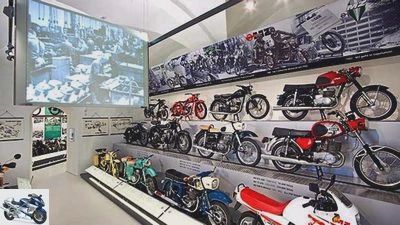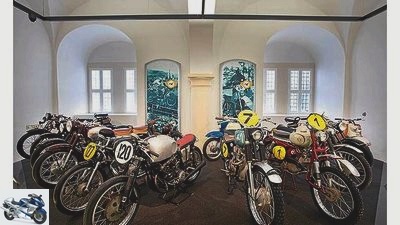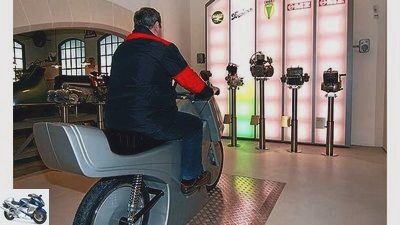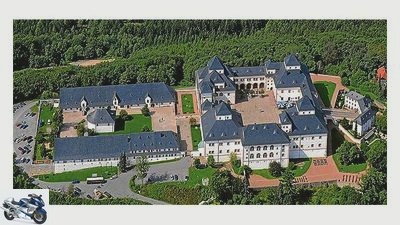Table of contents
- Scene: Augustusburg Castle Motorcycle Museum 175 motorcycles from almost 125 years
- Interview / information

to travel
Augustusburg Castle Motorcycle Museum
Scene: Augustusburg Castle Motorcycle Museum
175 motorcycles from almost 125 years
Content of
50 years after it was founded, the motorcycle museum in Augustusburg Castle has been expanded, renovated and modernized. Now 175 motorcycles from almost 125 years, from Ardie to Zundapp, presented two-wheeled history in an extremely aesthetic and sophisticated way.
04/15/2011
The first exhibits do not have an engine. Nonetheless, the trolley from 1830 and the 50 years younger penny farthing are important for the first room of the motorcycle museum in Augustusburg Castle. It shows in an impressive way what tremendous progress the Daimler dersche riding car of 1885 must have been. “From the wheel to the first series motorcycle” is the motto of the first department. The Hildebrand & Wolfmuller first introduced the term motor-wheel in 1894. The museum concept shows more than 175 motorcycles. The newly designed exhibition, which has been expanded by five halls, is also about connections. “We want to give people a feel for it,” says Uwe Meinig, director of the museum in Saxony, “what was special about the respective machines. It’s not just about technology, but also about the social and historical environment. “
The first three halls are intended to show visitors the development of the motorcycle up to 1920. This is the context in which Laurin’s single cylinder stands & Klement from 1899. In contrast, the Wanderer type 3 HP with V2 engine from 1910 as well as the four-cylinder FN from the same year show the rapid development of motorcycle construction in the early 20th century. “The new is the long-forgotten old,” says Uwe Meinig. The didactic principle of the museum is the instructive nature of the presentation: easily readable and informative texts provide information that in 1910 there were already 5,104 motorcycles in Germany.
Until then, there were no nationwide binding road signs and license plates in the German Reich. They were also only introduced in 1910. Spoken texts on “audio guides”, optionally in German, English or Czech, allow everyone to put together their own personal tour menu. Maybe you want to know more about the fact that 100 years ago the legislature first formulated requirements for brakes and lighting, speedometers and horns.
Furthermore, interactive screens, so-called touchscreens, illustrate topics at the touch of a finger. There are computer animations for all important assemblies of the motorcycle. They explain how a pendulum fork works or what crank drive and steam locomotive have in common. The museum shows two “two-wheeled cars” by Megola from the early 1920s, a sport and a tour. But also, multimedia, in the style of the 21st century, as its five-cylinder radial engine in the front wheel drove the extraordinary construction.
From the fourth room on, you can go through the history of motorcycling in Saxony. The show shows in detail the rise of DKW to become the largest motorcycle manufacturer in the world before the Second World War. The exhibition also does not suppress the role of the company and its products in the Nazi Reich, including the subsequent dismantling by the Soviets. Shows how MZ built on it. Nobody else in Europe built so many motorcycles during the Cold War, 2,545,112 units from 1950 to 1992. Consequently, the core of the Saxon exhibition is still the largest DKW collection and MZ show in the world.

BUR advertising agency
Suhler Sport: Viertaker for on-road and off-road, even with DOHC.
Which sounds logical in view of the location and the history of its origins: The former electoral hunting lodge Augustusburg is only ten kilometers away from Zschopau. At the end of the 1950s, the then MZ customer service manager Rudolf Hiller wanted to found a motorcycle museum in Zschopau. But there was no suitable building. So the “two-stroke motorcycle museum” opened on October 1st, 1961 in the previously empty kitchen wing of Augustusburg Castle. Initially with 40 exhibits on 400 m².
In 1985, in the 100th year of the motorcycle, the show was fundamentally expanded. Now 150 motorbikes were available in 18 rooms with a total area of 800 m². In 2011 there were 175 motorcycles on an impressive 1200 m² area. In addition, there are over 300 motorcycles that are parked in the depot in various restoration and conservation states and are not accessible to the public. Nevertheless, the machines from MZ and DKW alone are impressive. There is a DKW ULD 500 with a charge pump next to the two-cylinder, water-cooled Z 500 W, both from the pre-war era.
The whole arch spans the history of MZ: from the BK 350 – still under the IFA flag – as the first in-house development to the 500 R with a Rotax four-stroke single as the last motorcycle built in the old factory, before liquidation in 1992. Also the latest exhibit, a 1000 S from 2004, comes from MZ. The icing on the cake are otherwise never to be seen prototypes, such as the four-stroke test engine built before the fall of the Wall, studies for foreign currency exports or an air- and water-cooled prototype with a rotary engine: these were not allowed to be shown in GDR times. The museum extensively pays tribute to the glorious days of MZ and DKW in off-road sport and on the racetrack.
The highlight is the newly designed starting line-up of 16 famous racing motorcycles from Saxon production, from DKW’s singing saw to the two-cylinder MZ RZ 250. The loving ambience with cameraman, fan on wooden ladder and historical perimeter advertising brings the racing atmosphere of yore back to life. The same applies to the films produced specifically for the redesign of the museum, for example on MZ street sports with historical racing scenes and interviews with contemporary witnesses. That gets under your skin. “We wanted to use the power of moving images,” says Uwe Meinig. With success. You can feel how close the Sachsenring is, mentally and geographically.

BUR advertising agency
Quirky: The sound simulator imitates the sounds of the Wanderer V2, the DKW charge pump and MZ racing engines.
A special highlight: the sound simulator imitates the sounds of completely different machines. The visitor can electronically let a DKW charge pump, an MZ racing engine and an off-road sport engine, a Wanderer V2 and an AWO four-stroke engine roar at different speeds.
A whole range of other makes rounds off the exhibition. Nice ones like the newly restored Indian Chief, rare ones like the Ariel Leader with two-stroke twin or bizarre ones like the Welbike, which allied airborne troops dropped over France in 1944. A matter of honor are a white Mars and two three-seater Bohmerland.
If all of this is not enough, you can admire the carriage museum, the historical torture cellar, the hunting museum or the birds of prey demonstrations by the castle falconry and end your visit in the historic vaulted cellar restaurant. The family outing is definitely saved. And with winter and vintage car meetings in autumn, Augustusburg Castle is becoming more and more a Mecca for motorcyclists.
Interview / information

BUR advertising agency
Augustusberg Castle near Chemnitz.
Interview with the museum director of Augustusberg – Uwe Meining.
MOTORCYCLE CLASSIC: What gave the impetus for the renovation of your well-visited museum?
Uwe Meinig: Augustusburg Castle is home to one of the most important motorcycle collections in Europe and the most comprehensive DKW and MZ exhibition in the world. We offer a unique ambience and present motorcycles from the architecture of the late renaissance. This creates a very special feeling of space and turns the motorcycles into sculptures under six meter high cross vaults. We wanted to underline the special effect and mood, for example by using and emphasizing the height of the rooms with the new exhibition concept. In addition, we don’t just want to offer something to motorcycle freaks, but also to women and families who accompany them. In this concept, the visitors should understand the motorcycles in terms of their historical environment. We have produced our own films with unique historical material for this purpose. In addition, new, multimedia technologies are intended to loosen up and interrupt the static exhibition. These include interactive screens and electronic audio tours.
MOTORCYCLE CLASSIC: Are you satisfied with the conversion?
Uwe Meinig: Oh yes, that’s fantastic. The Free State of Saxony, which also owns all of our exhibits, has invested a lot of money. 1.3 million euros were invested in the new museum technology. From the beginning of the planning in 2003 until the reopening in January 2011, it was an elaborate process. But our team has confirmed the consistently positive response from visitors since then. The old exhibition was morally and technically worn out: We had to remove a lot of socialist text passages. And if you show the same thing for 20 years, you have to attract people again at some point. The effect of the new concept should be that people can always discover something new on their second and third visit.
Info
The palace complex is visible from afar on the Schellenberg above the town of Augustusburg and the Zschopau valley, around 17 kilometers south-east of Chemnitz. Motorcyclists can drive right up to the castle. There 175 motorcycles on 1200 m² of exhibition space impressively show the technical development of the motorcycle from 1885 to the present day. The address is: Waldstrasse 1, 09573 Augustusburg. It is open daily from 9.30 a.m. to 6 p.m. from November to March from 10 a.m. to 5 p.m. Admission costs 5 euros, reduced 3.80 euros. All five museums in the castle are available for 9.80 and 7.40 euros. Further information: Telephone 037291/3800 and www.die-sehenswerte-drei.de. Tip: It is best to stay overnight in the youth hostel on the castle grounds, in historical buildings, phone 037291/20256, www.jh-augustusburg.de.
Related articles
-
Harley-Davidson 19th pictures Cathcart 1/19 The new Harley-Davidson Museum opened on June 12, 2008 in Milwaukee at the corner of 6th Street and Canal…
-
Motorbike Fair Motorcycles Dortmund 2019
TWIN counselor traffic & business Motorbike Fair Motorcycles Dortmund 2019 Motorcycles Dortmund 2019 Motorcycle fair from 28.2. – 3.3. The Motorrader…
-
BMW R60-2 conversion: engine art for a museum
Fraser Evans 10 pictures Fraser Evans 1/10 Jay builds the Amadeus on behalf of an art museum for motorcycles. Fraser Evans 2/10 The core elements are the…
-
Barber Vintage Motorsports Museum – The Mecca for motorcyclists
Blacksmith 21 pictures Blacksmith 1/21 The Barber Vintage Motorsports Museum, founded in 1995, opened in 2003 in a specially built new building at its…
-
Motorbike rental in southern Europe and Turkey
Iron ham to travel Motorbike rental in southern Europe and Turkey Motorbike rental in southern Europe and Turkey Escape agent No question about it, there…
-
Piaggio Museum reopened in 2018
Piaggio Group 14th pictures Piaggio Group 1/14 The Piaggio Group has extensively renovated the factory museum. Piaggio Group 2/14 The museum was…
-
Motorbike tour through Carinthia
Daams 14th pictures Daams 1/14 Every meter of the alpine road is painstakingly punched into the field. Daams 2/14 Carinthia: Wonderful curves near clear…
-
Motorbike tour on Lake Constance – horsepower on the go with readers
Jahn to travel Motorbike tour on Lake Constance – horsepower on the move with readers House route PS – the corner paradise on the lake Out and about with…
-
Motorbike Tour – Madeira (Portugal)
Deleker 14th pictures Deleker 1/14 The old north coast road is a spectacle for all the senses, you’ll never forget that. Deleker 2/14 Sunset on the Pico…
-
Motorcycle Museum Motorcyclepedia Museum in Newburgh USA
Breakable 27 pictures Breakable 1/27 Is the Ghost Rider Bike one of the most impressive exhibits? Click through the photo show, then you can decide for…